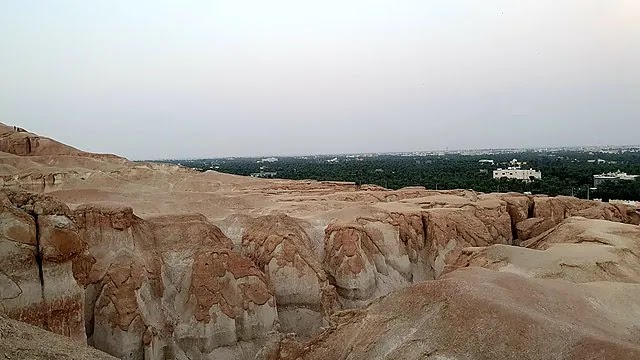
The desert means the vast land with vegetation and uninhabited. But in the heart of this desert, you can see the many oases. Al Ahsa Oasis Saudi Arabia is among them.
If there is a source of fresh water somewhere in the heart of the vast desert, green plants can grow around it. This oasis is a refuge for the Bedouins during long desert journeys.
People can build towns around this oasis, and trade and commerce can expand. One such oasis is the magnificent Al-Ahsa Oasis in Saudi.
Al Ahsa Oasis Saudi Arabia
The oasis is only 60 kilometers from the shores of the Persian Gulf. Because of the oasis, the Al-Ahsa district is now the greenest and most fertile in Saudi Arabia.

Most oases are small, but al-Ahsa is much bigger, covering about 75 square kilometers. The Al Ahsa Oasis in Saudi Arabia is 360 kilometers from the capital.
The capital of the Kingdom of Saudi Arabia is Riyadh. It is in the eastern province of the Kingdom of Saudi Arabia.
The people of Saudi call the oasis Mohafazat Al-Ahsa. It is the administrative area of Al-Ahsa Governor’s Office. The word ‘ahsa’ is the plural of the Arabic word ‘hasa’.
The word smile refers to a special kind of geo-natural phenomenon. Al-Hasa has a vast expanse alone and about 2.5 to 3 million date palms.
These date palms created an exceptional beauty in the heart of this Arabian desert. In the heart of the vast desert, hard, impermeable rock layers can form for millions of years.
It lies deep in the crust of the earth, and it has a layer of ordinary sand on its surface. Rainwater seeps into the sand and collects beneath when it rains in these areas.
As the lower rock layer is impermeable, this stored water does not lose in deep. Again, since there is a layer of sand on top, it does not become dry in the sun.
As a result, huge reservoirs took formation between the two. Placing wells in other places can remove this water.
The relationship between human civilization and the source of potable water is inseparable. Al-Ahsa has proof of ancient humans due to the plentiful freshwater visible in the desert.
There is no doubt that Al-Hasa Oasis Saudi Arabia is one of the oldest settlements on the Arabian Peninsula. There is evidence that this region had a connection with the ancient Levant.
It also had a connection with the Egyptian and Mesopotamian civilizations. Long ago, a farming community lived by Al-Ahsa because there was fresh water.
The people in the area learned to grow different crops by digging canals and watering them. The archaeological evidence suggests it.
Al-Hasa Oasis Saudi Arabia is the only place in the Arabian Peninsula where rice was grown. From ancient times the merchants used Al-Ahsa as a stopover.
Caravans often traveled across this land. They carried goods like pepper and incense. As a result, the city of Al-Ahsa began to prosper.
Besides farming, the people here were good at making things by hand, like weaving and sewing. Around 1000 AD, historians estimate that Al-Ahsa had a population of about 100,000.

It was the ninth-largest city in the world at that time. Plants start growing in the heart of the desert when they find water sources.
At first, of course, there is only water. But when the birds feel the presence of water while flying in the distant sky, they come down to the oasis.
And through the birds, various seeds spread around the water source. As the soil is fertile, plants grow from those seeds, and the oasis becomes a green forest.
Al-Hasa also has a vast forest cover of at least 10,000 hectares. Besides 25 to 30 lakh date palm trees in these forests, there are various varieties of grain and fruit trees.
Al-Ahsa’s date orchards produce at least 5 tons of dates a day. Al-Ahsa is well-known for Khalas dates and other tasty types.
The people of Al-Ahsa depend on its many natural springs for agriculture. There are at least 65 such fountains in Al Ahsa Oasis Saudi Arabia.
These are not only freshwater springs but also include warm water springs. Some of which sometimes reach temperatures of up to 32 degrees Celsius.
The most famous of these is the Ainzum spring. Its warm water is rich in sulfur. People believe it to be able to cure various diseases.
Al-Ahsa’s groundwater is 500 to 600 feet deep. They flow about 40-50 meters above the surface in some places, and water is extractable by the motor.
The largest springs in Ahsar can carry an average of 20,000 gallons of water per minute. All the fountains work as a container of one and a half million gallons of water per minute.
The water rises to the surface and creates springs and lakes in many places. It is not only these lakes that get water from the surrounding springs.
These attract tourists from home and abroad. People come here to eat or bathe in the forest. They also come to enjoy the natural scenery.
There are also bathrooms for women at many places near these lakes and fountains. Al-Ahsa is a popular place to visit and a significant port and city in Saudi.
The Ahsa district began to prosper after the discovery of oil in the nearby town of Dammam in the 1930s. The Al-Gawar oil field is in the Ahsa district, the world’s largest.

This oil field produces about 4.25 million barrels of oil every day. It is according to the authority. Al-Ahsa, known as the “gateway to Arabia,” is in the Persian Gulf.
Pilgrim caravans from southeastern Arabia always went through Al-Ahsa to get to Mecca.
It was the main transit between travel to Yemen and Iraq for a long time. The area is still one of the main routes from Saudi Arabia to neighboring UAE, Qatar, and Oman.
History
People have lived here since ancient times because there is lots of water in a dry area. Freshwater springs have appeared at oases in the region for thousands of years.
It has helped people live there and grow crops like date palms from ancient times. In 899 A.D., the region became independent from the Abbasid caliphate of Baghdad.
Before that, its early history was like that of Bahrain in eastern Arabia. The Qarmatian leader, Abu Tahir Al-Jannabi, took control of the region.
The capital of this area was near modern Hofuf. In 1077, the Uyunids overthrew the Qarmatian state from this unique area.
After the Bahrani dynasty of the Usfurids, the Jabrids took over and became a strong power in the region. They regained the islands of Bahrain from the princes of Hormuz.
The Portuguese Empire gained control of the Awal Islands in 1521, taking it from Muqrin ibn Zamil. He was the last ruler of Bahrain from the Jabrid dynasty.
Muqrin ibn Zamil bravely fought but lost the battle. The Jabrids had a hard time holding onto their position on the mainland.
The Ottomans and their tribal allies, the Muntafiq, were making it complex. In 1550, the Ottoman Empire of Suleiman I controlled this area and the nearby Qatif.
It was part of the Ottoman administrative system but mainly a vassal of the Porte. The Portuguese later took Qatif. In 1670, someone removed the Ottomans from this area.
After that, the chiefs of the Banu Khalid tribe took control of the region. In 1795, it and Qatif became part of the Wahhabist First Saudi State.
However, in 1818, Muhammad Ali of Egypt invaded and put it back under Ottoman control. The Second Saudi State took the region from the Banu Khalid rulers in 1830.
In 1871, the Ottomans occupied it again. They put it under Baghdad Vilayet and Basra Vilayet in 1875. Later, in 1913, Ibn Saud annexed Al-Ahsa and Qatif to Najd.
Percy Zachariah Cox told Kuwait’s Emir Sheikh Ahmad Al Sabah about border changes. It was December 2, 1922.
Major John More, the British representative in Kuwait, met with Ibn Saud that year. They wanted to settle the border issue between Kuwait and Najd.
The meeting ended with the Uqair Protocol of 1922. Britain agreed that Ibn Saud had control over territories claimed by the emir of Kuwait. In 1938, they found oil near Dammam.
It led to the area becoming modern quickly. By the early 1960s, they were producing 1 million barrels per day.
Conclusion
Al Ahsa Oasis Saudi Arabia is famous not only as an oasis but also as a symbol of the ancient city. Much of its rich historical and archeological remains are still intact.
The oasis-centric cities have ancient mosques, forts, wells, canals, and irrigation systems. It still bears witness to its thousands of years of history, culture, and civilization.
In 2018, UNESCO recognized Al-Ahsa as a World Heritage Site. The UNESCO website says al-Ahsa shows how nature and humans interact amazingly.
- The Largest Hot Desert in The World: The Great Sahara
- A COMPLETE LIST OF UNION PARISHADS IN BANGLADESH
- Lac de Gafsa: A Mysterious Lake in Tunisian Desert

A Bangladeshi entrepreneur. A person who loves nature, a web developer, and the founder of Srigal and Nehrin.